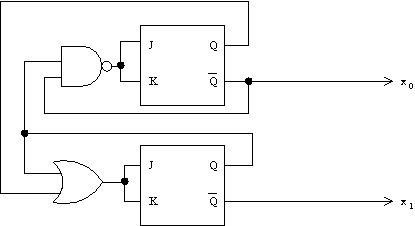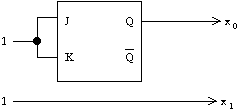3
a) Taking the Qbar outputs instead of the Q outputs for a two-bit counter
yields the sequence 11, 10, 01, 00, repeat. This is close. We just need to
skip the 00 step. This is when the two Q outputs are 1 (since we're taking
the Qbar outputs), so we need a two-bit counter which skips 11. We'll skip 11
by saying that when the output is 10, the high bit unexpectedly flips and the
low bit unexpectedly doesn't. Thus, the low bit flips when the value is not
10 (as opposed to flipping always), and the high bit flips, instead of when
x0, rather when x0+(x1 notx0), which equals x0+x1.

There are many other ways to do this, of course.
b) The low bit flips always, and the high bit is a constant one:

[exam]
[main course page]


